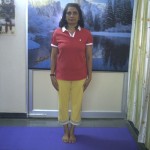
Practicing Yoga postures can be a powerful and effective healing modality for trauma survivors. One of the primary defenses of trauma survivors is to repress or dissociate from painful memories and emotions. Yoga asanas and Yogic breathing techniques help a trauma survivor to be aware of his or her own boundaries, feelings and anger at being victimized. This new emotional awareness will empower a trauma survivor to speak his or her truth. This is one of the building blocks of healing from trauma. Continually repressing painful emotions and experiences will contract the flow of energy throughout the body, leading to fatigue and aches and pains.
Beginning Yoga postures for trauma survivors gently open up the doorway to somatic awareness. These beginning postures, if offered by a trauma-sensitive Yoga instructor, will also empower the survivor to choose to practice the poses that nourish his or her well being and to decline from practicing the poses that do not without necessitating an explanation. Mountain Pose or Tadasana is great pose for helping a trauma survivor to feel centered and grounded. Uttanasana or Forward Fold will help a trauma survivor to look within as he or she releases tension that resides in the hamstrings.
Tadasana or Mountain Pose
To practice Tadasana, come to the front end of your Yoga mat and stand comfortably in Samasthiti or Equal Standing Pose. Your feet may be touching or a few inches apart. Feel the weight of your body being supported by your feet, and how the distance of your feet from each other impacts your balance. Choose a distance that is comfortable for you today. It is fine if the distance of your feet changes from day to day. Breathe deeply and fully three to five times, while feeling the entire surface area of your feet. Feel the earth below you, and how you are supported in this moment.
Uttanasana or Forward Folding Pose
Often emotional conflict and holding resides in the hamstrings and hips. Practicing Uttanasana will help a trauma survivor to become aware of tightness in the hamstrings and conflicted feelings that may be residing in those muscles. To practice this posture, start from Tadasana. Take one, full complete breath. With your next exhale; bend forward as far as you comfortably can without strain. Let your head hang down and clasp your elbows with the opposite hands. Close your eyes and become aware of any sensations, feelings and memories. Witness these sensations, memories and feelings with deep compassion and love for yourself as you continue to breath. To come out of the posture, place your hands on your hips and with your next inhale slowly come back up into Mountain Pose.
© Copyright – Aura Wellness Center – Publications Division
Join our newsletter and get a free report, videos, podcasts, and e-Book, “Yoga in Practice.”
See our testimonials to find out what our graduates have to say about our selection of online yoga teacher certification courses.
Please feel free to share our posts with your friends, colleagues, and favorite social media networks.

Mountain Pose or Tadasana is great pose for helping a trauma survivor to feel centered and grounded. Thank you Kimaya Singh for writing this good article.